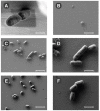Metallacarborane Derivatives Effective against Pseudomonas aeruginosa and Yersinia enterocolitica
- PMID: 34201818
- PMCID: PMC8267647
- DOI: 10.3390/ijms22136762
Metallacarborane Derivatives Effective against Pseudomonas aeruginosa and Yersinia enterocolitica
Abstract
Pseudomonas aeruginosa is an opportunistic human pathogen that has become a nosocomial health problem worldwide. The pathogen has multiple drug removal and virulence secretion systems, is resistant to many antibiotics, and there is no commercial vaccine against it. Yersinia pestis is a zoonotic pathogen that is on the Select Agents list. The bacterium is the deadliest pathogen known to humans and antibiotic-resistant strains are appearing naturally. There is no commercial vaccine against the pathogen, either. In the current work, novel compounds based on metallacarborane cage were studied on strains of Pseudomonas aeruginosa and a Yersinia pestis substitute, Yersinia enterocolitica. The representative compounds had IC50 values below 10 µM against Y. enterocolitica and values of 20-50 μM against P. aeruginosa. Artificial generation of compound-resistant Y. enterocolitica suggested a common mechanism for drug resistance, the first reported in the literature, and suggested N-linked metallacarboranes as impervious to cellular mechanisms of resistance generation. SEM analysis of the compound-resistant strains showed that the compounds had a predominantly bacteriostatic effect and blocked bacterial cell division in Y. enterocolitica. The compounds could be a starting point towards novel anti-Yersinia drugs and the strategy presented here proposes a mechanism to bypass any future drug resistance in bacteria.
Keywords: COSAN; Pseudomonas aeruginosa; Yersinia enterocolitica; antibacterials; boron clusters; metallacarboranes; resistance generation.
Conflict of interest statement
The authors declare no conflict of interest.
Figures






Similar articles
-
[Antimicrobial susceptibility of Yersinia enterocolitica and Yersinia pseudotuberculosis strains isolated from humans in Poland during 2004-2009].Med Dosw Mikrobiol. 2009;61(4):311-9. Med Dosw Mikrobiol. 2009. PMID: 20201320 Polish.
-
Heterogeneity of Highly Susceptible Yersinia enterocolitica Isolates of Clinical and Environmental Origin: A 5-Year Survey from Iran (2011-2016).Microb Drug Resist. 2020 Jan;26(1):46-53. doi: 10.1089/mdr.2018.0469. Epub 2019 Aug 16. Microb Drug Resist. 2020. PMID: 31414976
-
Molecular evaluation of quorum quenching potential of vanillic acid against Yersinia enterocolitica through transcriptomic and in silico analysis.J Med Microbiol. 2020 Nov;69(11):1319-1331. doi: 10.1099/jmm.0.001261. Epub 2020 Oct 21. J Med Microbiol. 2020. PMID: 33084565
-
Yersinia enterocolitica: pathogenesis, virulence and antimicrobial resistance.Enferm Infecc Microbiol Clin. 2012 Jan;30(1):24-32. doi: 10.1016/j.eimc.2011.07.017. Epub 2011 Oct 22. Enferm Infecc Microbiol Clin. 2012. PMID: 22019131 Review.
-
Yersinia enterocolitica, a primary model for bacterial invasiveness.Rev Infect Dis. 1987 Jan-Feb;9(1):64-87. doi: 10.1093/clinids/9.1.64. Rev Infect Dis. 1987. PMID: 3547579 Review.
Cited by
-
Synthesis and Antibacterial Activity Studies of the Conjugates of Curcumin with closo-Dodecaborate and Cobalt Bis(Dicarbollide) Boron Clusters.Molecules. 2022 May 3;27(9):2920. doi: 10.3390/molecules27092920. Molecules. 2022. PMID: 35566270 Free PMC article.
-
Synthesis of Boronated Amidines by Addition of Amines to Nitrilium Derivative of Cobalt Bis(Dicarbollide).Molecules. 2021 Oct 29;26(21):6544. doi: 10.3390/molecules26216544. Molecules. 2021. PMID: 34770953 Free PMC article.
-
Chemistry of Carbon-Substituted Derivatives of Cobalt Bis(dicarbollide)(1-) Ion and Recent Progress in Boron Substitution.Molecules. 2023 Oct 7;28(19):6971. doi: 10.3390/molecules28196971. Molecules. 2023. PMID: 37836814 Free PMC article. Review.
-
Bis(Dicarbollide) Complexes of Transition Metals: How Substituents in Dicarbollide Ligands Affect the Geometry and Properties of the Complexes.Molecules. 2024 Jul 26;29(15):3510. doi: 10.3390/molecules29153510. Molecules. 2024. PMID: 39124915 Free PMC article. Review.
-
Carboranes as unique pharmacophores in antitumor medicinal chemistry.Mol Ther Oncolytics. 2022 Jan 10;24:400-416. doi: 10.1016/j.omto.2022.01.005. eCollection 2022 Mar 17. Mol Ther Oncolytics. 2022. PMID: 35141397 Free PMC article. Review.
References
MeSH terms
Substances
Grants and funding
LinkOut - more resources
Full Text Sources
Medical

